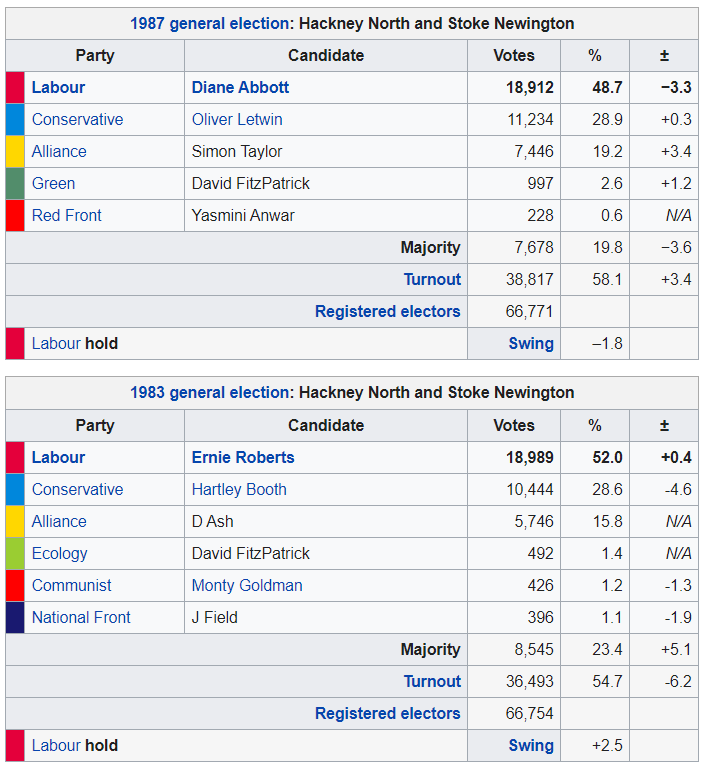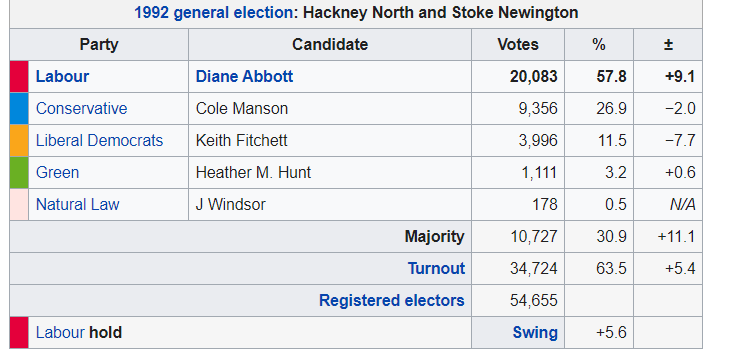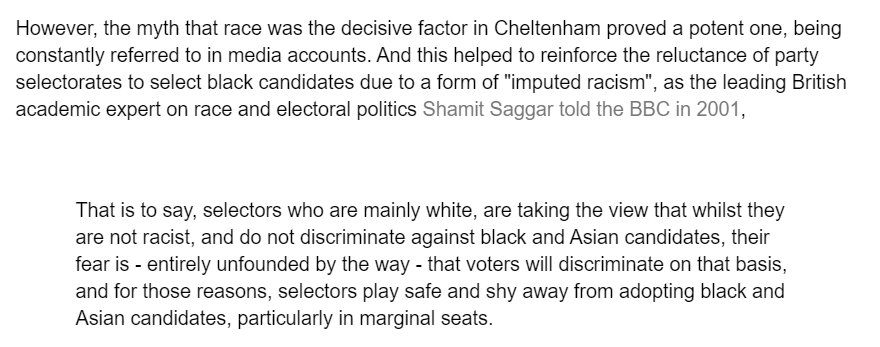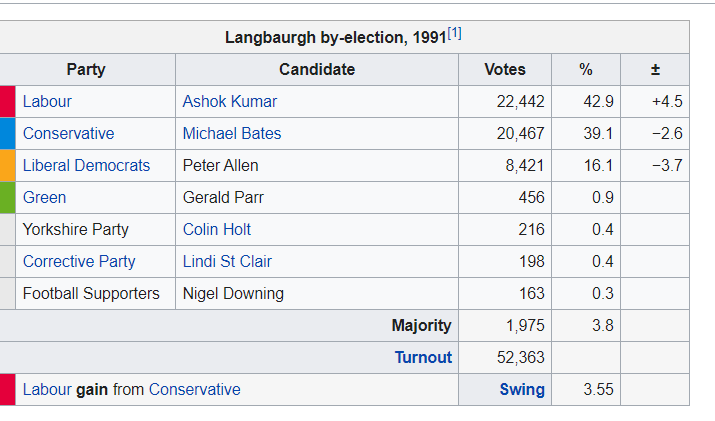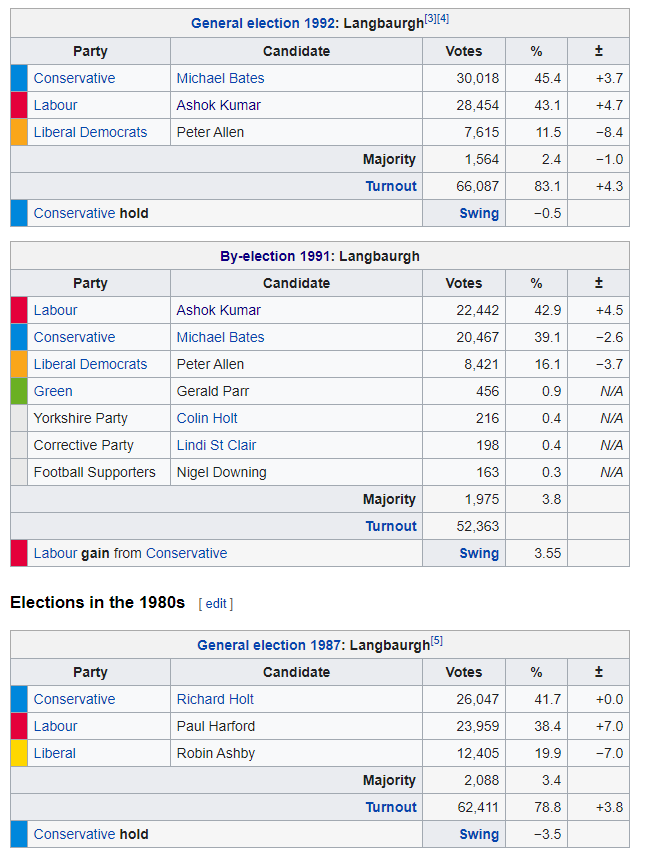This Guardian extract from Robin Bunce and Samara Linton& #39;s biography of Diane Abbott reports uncertainty among local Labour activists, and in parliament, about the public reception of a black woman running for Parliament in Hackney in 1987 https://www.theguardian.com/politics/2020/sep/29/how-diane-abbott-fought-racism-and-her-own-party-to-become-britains-first-black-female-mp?CMP=share_btn_tw">https://www.theguardian.com/politics/...
Diane Abbott won 18,912 votes - just 77 fewer votes than the Labour candidate 4 years earlier, though the Labour vote share was 49% rather than 52%. There was an increased turnout (+3.4%), with Oliver Letwin adding 800 votes and the Alliance candidate adding 1700 votes.
After one term as MP, Diane Abbott won 58% of vote in 1992, as LibDem and Conservative vote and vote-share fell, and turnout rose. (The academic evidence suggests small ethnic penalties for first-time candidates, which diminish or disappear for incumbents seeking re-election)
Hackney 1987 result supports hypothesis that "imputed prejudice" - selectorates fearing yet also exaggerating racial prejudice of voters - put significant brake on ethnic diversity in parliament esp 1983-2005 period, as Shamit Saggar argued in 2001
http://www.bbc.co.uk/otr/intext/20001008_film_1.html">https://www.bbc.co.uk/otr/intex...
http://www.bbc.co.uk/otr/intext/20001008_film_1.html">https://www.bbc.co.uk/otr/intex...
Significantly exacerbated by a political/media folk memory (mythology) of Tory loss of Cheltenham in 1992, which is still misremembered/misreported by political classes as loss of a safe seat due to candidate being black. Which the evidence doesn& #39;t support
http://www.nextleft.org/2010/07/lord-taylor-and-myth-of-cheltenham-1992.html">https://www.nextleft.org/2010/07/l...
http://www.nextleft.org/2010/07/lord-taylor-and-myth-of-cheltenham-1992.html">https://www.nextleft.org/2010/07/l...
Abbott was the only black female MP for a decade. Two black women were MPs in the 20th century. No Asian woman was an MP until 2010.
There are now 37 ethnic minority female MPs in 2020 (rising from just 3 in 2009), alongside 28 ethnic minority male MPs https://twitter.com/sundersays/status/1271123966145581058">https://twitter.com/sundersay...
There are now 37 ethnic minority female MPs in 2020 (rising from just 3 in 2009), alongside 28 ethnic minority male MPs https://twitter.com/sundersays/status/1271123966145581058">https://twitter.com/sundersay...
Labour did select an Asian candidate, for a Tory-held by-election in 1991, in the 99% white British seat of Cleveland. Ashok Kumar won the seat, though the Conservatives regained it in the 1992 General Election
There seems to be little evidence of candidate ethnicity playing any significant role in that closely fought Red/Blue wall marginal in 1991-1992. Kumar then won the new Middlesbrough South seat in 1997.
Despite that, Labour now seldom selects non-white candidates in lower diversity seats
Cons breakthrough 2010-2019 includes ongoing reluctance to run non-white candidates in marginals. Black/Asian candidates in Conservative-held seats (usually low levels of ethnic diversity)
Cons breakthrough 2010-2019 includes ongoing reluctance to run non-white candidates in marginals. Black/Asian candidates in Conservative-held seats (usually low levels of ethnic diversity)
Transcript of On The Record package, Oct 2000, on barriers to ethnic diversity in politics, with 9 MPs out of 650 in the Blair era. Features Diane Abbott, Trevor Phillips, Oona King and Shamit Saggar.
http://www.bbc.co.uk/otr/intext/20001008_film_1.html">https://www.bbc.co.uk/otr/intex...
http://www.bbc.co.uk/otr/intext/20001008_film_1.html">https://www.bbc.co.uk/otr/intex...

 Read on Twitter
Read on Twitter